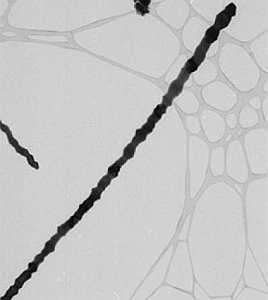Materials scientists and biomedical engineers at Ohio State University in Columbus designed a coating of nanowires that can help improve the bonding between human bone and implant materials. The team led by Ohio State materials scientist Sheikh Akbar published its results in this month’s issue of the journal Ceramics International (paid subscription required).
The process devised by Akbar and colleagues grows nanoscale filaments of titanium dioxide on a smooth surface of titanium — a material used in human implants — with an oxidation process in a furnace heated to 1,300 degrees F. The process that Akbar calls “nanostructures by material design” takes advantage of the physical and chemical properties of titanium, with no further milling or fabrication.
In their tests, the researchers discovered the fine nanoscale titanium dioxide filaments also grew a layer of aluminum oxide on the outside of the wires, in a process that they could not explain, since the team worked with pure titanium and not an alloy containing aluminum.The outside layer on the wires, say the researchers, resembles a layer of bark on a tree.
The Ohio State team then tested the ability to grow human cells on various surfaces: smooth titanium, smooth titanium dioxide, and titanium dioxide coated with the nanowires. For the test, the researchers used human osteosarcoma cells, a malignant bone cancer with particularly hardy cells that also resemble healthy bone tissue. The tests measured concentrations of alkaline phosphatase, an enzyme associated with bone development, and an indicator of bone tissue formation.
The results showed within 15 hours a 20 percent greater concentration of alkaline phosphatase produced by the cells on the nanowire-coated surface. The researchers report the nanowire-coated surface eventually grew some 90,000 cells per square centimeter, compared to 50,000 cells per square centimeter on the smooth surfaces.
Biomedical engineering professor and co-author Derek Hansford says the discovery has potential for strengthening the connection between bone and implant for hip and knee replacements, repairing broken bones, and dental implants. “A stronger interface,” says Hansford, “means that implants and bones will be better able to share mechanical loads, and we can better preserve healthy bone and soft tissue around the implant site.”
Akbar says the process is simple enough to learn, and relatively inexpensive. He estimates about $100 worth of metal foil can produce hundreds of samples.
Read more:
- Cell Therapy Technique Tested to Regenerate Back Discs
- 3-D Printing, Computer Model Generate Synthetic Bone Matter
- Silk, Cellulose Provide Useful Scaffold to Repair Cartilage
- FDA OKs Trial of Biopolymer to Treat Spinal Cord Injury
- Biotech, University to Partner on Bone Regeneration Trial
* * *


 RSS - Posts
RSS - Posts
You must be logged in to post a comment.